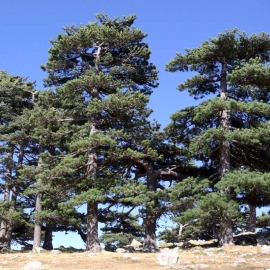




Organic Austrian Pine Seeds (Pinus Nigra)
1.14 €
The Austrian Pine is a handsome large growing tree native to Austria and most of the Balkans. It can be long lived, with some trees over 500 years old. It needs full sun to grow well and is intolerant of shade.
-
Organic Austrian Pine (Pinus Nigra)
The Austrian Pine is a handsome large growing tree native to Austria and most of the Balkans. It can be long lived, with some trees over 500 years old. It needs full sun to grow well and is intolerant of shade. This is a very hardy tree that is resistant to snow and ice damage.
Succeeds on most soil types, including chalk, but dislikes poorly drained moor land soils. It establishes quickly and soon becomes fast growing forming a densely needled shapely tree making it very popular for landscape planting, it has also been extensively planted for timber and in shelter-belts.
In many parts of Europe it is planted as an ornamental tree in parks and gardens and also as a street tree. Its value as a street tree is largely due to its resistance to salt spray (from road de-icing salt) and various industrial pollutants. It is also suitable for coastal planting.
It is sometimes grown for the Christmas Tree trade because of it's rapid growth, dense form and deep green colour, but the extreme length of the needles can make it difficult to decorate.
How to Grow
Austrian Pine seeds are relatively easy to germinate and grow. The dormancy within the seed is short and easily broken and reasonable success can be expected even when seeds are sown without any form of pre-treatment. The benefit of a short period of pre-treatment is that a greater percentage of seeds will germinate and the germination of the seedlings will be syncronised with most seedlings germinating within a few days of each other.
Soak the seeds in water for 24 hours. Fully drain away all of the water and place the seeds in a zip-lock freezer bag. Place the seeds in the fridge, it is important that during this period that the seeds do not dry out or are waterlogged otherwise the pre-treatment will be ineffective.
It is important to keep checking the seeds every week or so to make sure that they are not drying out. You could also at the start of treatment incorporate a little damp vermiculite or perlite, this helps to keep the seeds moist but not waterlogged.
Seeds should be sown into containers filled with a good quality general potting compost. Suitable containers could be plant pots, seed trays or plug trays or even improvised containers with drainage holes. Firm the compost gently and sow the seeds on the surface. If you are sowing in plug trays, sow 1 or 2 seeds per cell.
Cover the seeds with a couple of millimeters of vermiculite or failing that a fine layer of sieved compost. Follow with a gentle watering and keep them at room temperature. Germination will begin within a 10-14 days of sowing.
The seedlings are reasonably robust and trouble free and usually grow to a height of between 3 and 10 cm in the first growing season depending on the sowing date and cultural techniques.
Developing seedlings should be fine in full sun, keep them well watered and free of competing weeds.
Growth will accelerate in the second and subsequent years and the developing young trees should be re-potted as necessary preferably during the dormant season. After perhaps 2 or 3 years they are ready to be planted in their permanent position
This species will grow very large, very rapidly so plant it well away from buildings, power lines, etc.
